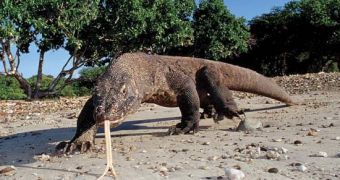When Europeans heard about it for the first time, they thought it was a legend. But the existence of the huge lizard whose skin could not be penetrated by bullets was real. The Komodo dragon (Varanus komodoensis) is the world largest living lizard: males can be up to 3 m (10 ft) long and weigh 150-200 kg (320-440 pounds). Females are smaller.
Even if the reptile can swim on long distances into the ocean, it is restricted to the Indonesian islands of Komodo, Rintja and Padar, plus some coastal areas of Flores. Some believe that the existence of these huge lizards is connected to that of extinct ancient fauna, like dwarf elephants and hippopotamuses. Anyway, the dragon, which is a species of monitor lizards, misses in islands devoid of sambar deer (Cervus timorensis). Locally, the dragons are called buaja darat ("ground crocodile").
The Komodo dragon has a large head with powerful jaws and crenelated teeth that can pierce through the thick skin of large animals. The 30 cm (1 ft) long tongue can be projected out of the mouth to pick up and bring to an olfactory organ located to the top of the mouth scent molecules.
The animal moves slowly, dragging the tail, but it is capable of short bursts of very rapid running, when they can easily overcome a human. The tail is extremely powerful and with a whip it can bring down a water buffalo or deer.
The female lays about 25 eggs, buried in a nest made onto the ground. The new hatched dragons are 30 cm (1 ft) long and grow very slowly. When small, they must avoid larger dragons (which would eat them) by living in the trees. By the age of 15 years, they are 1.5 m (5 ft) long. The Komodo dragon can live up to 50 years.
In 2006, two Komodo dragon females reproduced through "virgin births" or "parthenogenesis", without mating with a male. Tests revealed the offspring were not clones of their mother, but their genetic make-up was derived only from hers, being the result of asexual reproduction. The animals were living in captivity without male access for years, therefore the ability to reproduce parthenogenetically seems to be an ancestral capability. It could cause a female, washed up alone on an island with no males, to establish a population.
The giant reptile is 100 % meat eater, killing buffaloes, deer, bewildered horses but it also scavenge on corpses. They generally avoid people, but accidents have occurred along the time. The bite is extremely dangerous due to its power, but also because the saliva of the dragon is mildly venomous (monitor lizards are venomous, and share a common origin with the snakes). Moreover, the saliva is loaded with extremely infectious bacteria.
The huge claws can tear buffalo thick skin, being formidable weapons too. When the animal is ready to attack, the neck swells, the mouth is opened and the tail is whipped nervously. Hunting takes place both during the day and the night. A dragon with a full belly retreats for a while in the burrow to digest its meal.
Often, dragons involve in fights for carcases and large males chase away the other individuals.
Dragons don't seem to hear well, but eyesight is good, despite the reduced visual field and lateral positioning of the eyes.
In Komodo, dragons are protected in a National Park hosting about 1,000 individuals. The park is also a refuge for other lizards or snakes, birds, sambar deer, buffaloes, horses and wild boars. To protect the dragon, the practice of grass firing has been forbidden and even the agriculture has been abandoned in some areas. Yet, poaching represents a problem, as well as the straying dogs that eat the eggs of the dragons.
Between 1927-1928, Chinese traders organized an intensive poaching for extracting a fat from the tail of the dragons, used for the preparation of a "miraculous" ointment for treating the skin diseases. Fortunately, the enlightened sultan of Bima (Flores) imposed a strict protection of the species since 1915, several years after the species was discovered by the Europeans.
Another 500 individuals inhabit Rintja, Padar and Flores, but, in these places, the large reptiles are fearful, and rarely can be seen. We hope the "living T-rex" will continue living with us.

 14 DAY TRIAL //
14 DAY TRIAL //